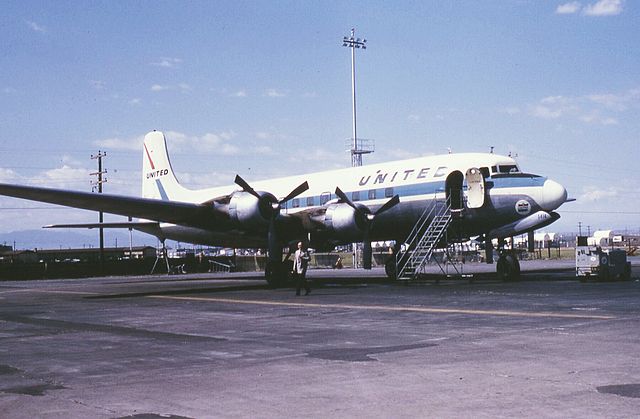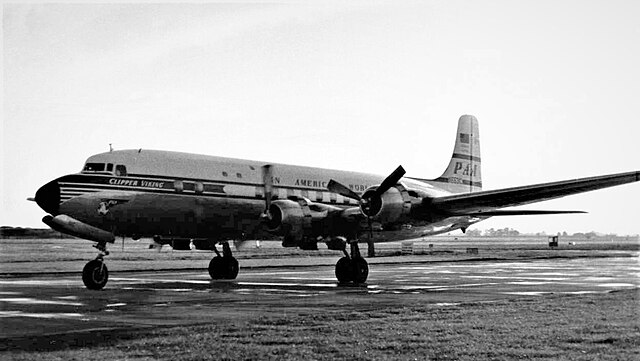Loading AI tools
US airliner with 4 piston engines, 1946 From Wikipedia, the free encyclopedia
The Douglas DC-6 is a piston-powered airliner and cargo aircraft built by the Douglas Aircraft Company from 1946 to 1958. Originally intended as a military transport near the end of World War II, Douglas reworked it after the war to compete with the Lockheed Constellation in the long-range commercial transport market. Douglas built over 700, and many still fly in cargo, military, and wildfire control roles.
| DC-6 | |
|---|---|
 A Douglas DC-6B of Western Airlines, Oct 1956 | |
| General information | |
| Type | Airliner/transport aircraft |
| Manufacturer | Douglas Aircraft Company |
| Status | In limited service |
| Primary users | Pan American World Airways |
| Number built | 704 |
| History | |
| Manufactured | 1946–1958 |
| Introduction date | March 1947 with American Airlines and United Airlines |
| First flight | 15 February 1946 |
| Developed from | Douglas DC-4 |
| Developed into | Douglas DC-7 |
The DC-6 was known as the C-118 Liftmaster in United States Air Force service and as the R6D in United States Navy service before 1962, after which all U.S. Navy variants were also designated as the C-118.

The United States Army Air Forces commissioned the DC-6 project as the XC-112 in 1944. The Army Air Forces wanted a lengthened, pressurized version of the DC-4-based C-54 Skymaster transport with more powerful engines. By the time the prototype XC-112A flew on 15 February 1946, the war was over, the USAAF had rescinded its requirement, and the aircraft was converted to YC-112A, being sold in 1955.[1]
Douglas Aircraft modified the design into a civil transport 80 in (200 cm) longer than the DC-4. The civil DC-6 first flew on 29 June 1946, being retained by Douglas for testing. The first airline deliveries were to American Airlines and United Airlines on 24 November 1946.[1] A series of inflight fires (including the fatal crash of United Airlines Flight 608) grounded the DC-6 fleet in 1947. The cause was found to be a fuel vent next to the cabin cooling turbine intake; all DC-6s were modified, and the fleet was flying again after four months on the ground.

In April 1949, United, American, Delta, National, and Braniff were flying DC-6s in the United States. United flew them to Hawaii, Braniff flew them to Rio de Janeiro, and Panagra flew Miami-Buenos Aires; KLM, SAS, and Sabena flew DC-6s across the Atlantic. BCPA DC-6s flew Sydney to Vancouver, and Philippine flew Manila to London and Manila to San Francisco.
Pan Am used DC-6Bs to start transatlantic tourist-class flights in 1952. These were the first DC-6Bs that could gross 107,000 lb (49,000 kg), with CB-17 engines rated at 2,500 hp (1,900 kW) on 108/135 octane fuel. Several European airlines followed with transatlantic services. The DC-6B and C subtypes could often fly nonstop from the eastern US to Europe but needed to refuel in Goose Bay, Labrador, or Gander, Newfoundland, when flying westbound into prevailing westerly winds.[2]
Douglas designed four variants of the DC-6: the basic DC-6, and the longer-fuselage (60 in (150 cm)) higher-gross-weight, longer-range versions—the DC-6A with cargo doors forward and aft of the wing on the left side, with a cargo floor; the DC-6B for passenger work, with passenger doors only and a lighter floor; and the DC-6C convertible, with the two cargo doors and removable passenger seats.
The DC-6B, originally powered by Double Wasp engines with Hamilton Standard 43E60 constant-speed reversing propellers, was regarded as the ultimate piston-engine airliner from the standpoint of ruggedness, reliability, economical operation, and handling qualities.[3]
Similar to the DC-6A, the military version was the USAF C-118 Liftmaster; the USN R6D version used the more powerful R-2800-CB-17 engines. These were later used on the commercial DC-6B to allow international flights.[4] The R6D Navy version (in the late 1950s and early 1960s) had Curtiss Electric constant-speed reversing propellers.[citation needed]
The USAF and USN renewed their interest in the DC-6 during the Korean War and ordered 167 C-118/R6D aircraft, some of which later found their way to civil airlines. Harry Truman's first presidential aircraft was an Air Force short-fuselage DC-6 which was designated VC-118, and named The Independence. It is preserved in the National Museum of the United States Air Force at Dayton, Ohio.
Total production of the DC-6 series was 704, including military versions.[5]
In the 1960s two DC-6s were used as transmitter platforms for educational television, based at Purdue University, in a program called the Midwest Program on Airborne Television Instruction.[6]
Many older DC-6s were replaced in airline passenger service from the mid-1950s by the Douglas DC-7, but the simpler, more economical engines in the DC-6 have meant the type has outlived the DC-7, particularly for cargo operations. DC-6/7s surviving into the jet age were replaced in frontline intercontinental passenger service by the Boeing 707 and Douglas DC-8.
Basic prices of a new DC-6 in 1946–47 were around £210,000–£230,000 and had risen to £310,000 by 1951. By 1960, used prices were around £175,000 per aircraft.[7] Prices for the DC-6A in 1957–58 were £460,000–£480,000. By 1960, used prices were around £296,000.[7] Equivalent prices for the DC-6B in 1958 were around £500,000. Used prices in 1960 were around £227,000.[7]
From 1977 to 1990, five yellow-painted Douglas DC-6Bs were used as water bombers in France by the Sécurité Civile. They were registered F-ZBAC, F-ZBAD, F-ZBAE, F-ZBAP, and F-ZBBU.[8]






Today, most DC-6s are inactive, stored, or preserved in museums. Several DC-6s fly in northern bush operations in Alaska, while several are based in Europe, and a few are still in operation for small carriers in South America.
Many airlines and air forces from several countries included the DC-6 in their fleets at some point in time; these are further detailed in the list of Douglas DC-6 operators. In the 1980s, several DC-6Bs were used as fire retardant tankers by Conair Aerial Firefighting of Abbotsford, Canada. Douglas sold the last aircraft to Everts Air Cargo in Fairbanks, AK, in the late 2000s.
As of 2014[update], 147 DC-6s survived, of which 47 were airworthy; several were preserved in museums.


| Variant | DC-6 | DC-6A | DC-6B |
|---|---|---|---|
| Crew | Three to four | ||
| Capacity | 48-68 passengers | 28,188 lb (12,786 kg) of cargo | 42-89 passengers |
| Length | 100 ft 7 in (30.66 m) | 105 ft 7 in (32.18 m) | |
| Wingspan | 117 ft 6 in (35.81 m) | ||
| Height | 28 ft 5 in (8.66 m) | ||
| Wing area | 1,463 sq ft (135.9 m2) | ||
| Empty weight | 52,567 lb (23,844 kg) | 45,862 lb (20,803 kg) | 55,357 lb (25,110 kg) |
| Max takeoff weight | 97,200 lb (44,100 kg) | 107,200 lb (48,600 kg) | 107,000 lb (49,000 kg) |
| Powerplant (4x) | Pratt & Whitney R-2800-CA15 "Double Wasp" radial engine, 2,400 hp (1,800 kW) with water injection each | Pratt & Whitney R-2800-CB16 "Double Wasp" radial engine, 2,400 hp (1,800 kW) with water injection each | Pratt & Whitney R-2800-CB17 "Double Wasp" radial engine, 2,500 hp (1,900 kW) with water injection each |
| Propellers | Hamilton Standard 43E60 "Hydromatic" constant-speed props with autofeather and reverse thrust | ||
| Cruise speed | 311 mph (501 km/h) | 315 mph (507 km/h) | |
| Fuel capacity | 4,260 US gal (16,100 L) 4,722 US gal (17,870 L) | up to 5,512 US gal (20,870 L) | |
| Range | 3,983 nmi (7,377 km) | 2,948 nmi (5,460 km) Max payload 4,317 nmi (7,995 km) Max fuel | 2,610 nmi (4,830 km) Max payload 4,100 nmi (7,600 km) Max fuel |
| Service ceiling | 21,900 ft (6,700 m) | 25,000 ft (7,600 m) | |
| Rate of climb | 1,070 ft/min (330 m/min) | ||
Related development
Aircraft of comparable role, configuration, and era
Related lists
Seamless Wikipedia browsing. On steroids.
Every time you click a link to Wikipedia, Wiktionary or Wikiquote in your browser's search results, it will show the modern Wikiwand interface.
Wikiwand extension is a five stars, simple, with minimum permission required to keep your browsing private, safe and transparent.